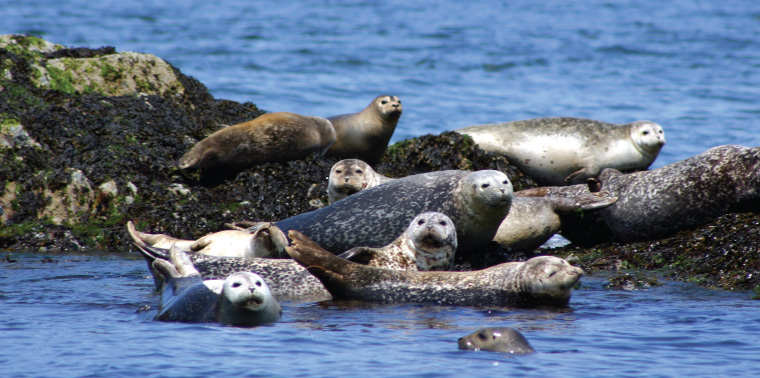February 26, 2013 — A seal’s niche in the marine food web is sweet: prey to just a few other animals, predator to many, including cod, mackerel, herring, octopus, shrimp and shellfish. But those prey may be as deadly to a seal as a hungry shark would be: Many contain residues of manmade pesticides, industrial chemicals and coal ash. Prey usually aren’t sickened by the relatively small amounts of these chemicals that they carry, but seals and other top predators that feed on them collect and concentrate these toxins in their fat and organs. Such toxins are linked to reproductive, developmental, nervous system and other harms in both wildlife and humans, and they have spread worldwide.
These substances are so prevalent that the term “PBT” — for persistent, bioaccumulative and toxic — is used to describe them. Most were intentionally designed to resist breaking down in the environment, such as the pesticide DDT: banned in the U.S. since 1972 (and worldwide under the Stockholm Convention, which went into effect in 2004) for any use other than malaria control, it continues to show up a decade or more after initial use. Another class of PBTs, polychlorinated biphenyls (PCBs), was banned in 1979 in the U.S., but new leaks occur all the time as old electrical equipment breaks or gets thrown away.
Polybrominated diphenyl ethers (PBDEs) are a class of PBTs chemically similar to PCBs that are used as flame retardants. Millions of pounds per year have been used since the late 1970s in many common products such as mattresses, upholstery foam and the plastic casings for electronics. Although manufacturers phased out penta- and octa-BDE nearly a decade ago, and several states have banned them as well, countless objects still contain them. State bans on deca-PBDE came later, and manufacturers and importers agreed in 2010 to a national phase-out, with sales to cease at the end of 2013.
Tiny particles of PBDE-treated upholstery foam, plastic, or fabric slough off our beds, couches, curtains and televisions and end up in the air, washed down the drain or thrown out with the garbage. Other PBTs can leak into the air from manufacturing plants, evaporate off cropland, or leach out of landfills. Wind and rain cycles transport them hundreds or thousands of miles from their origins, to drop with dust micro-particles or rain onto land or water below. Some portion re-evaporates into the air, and the chemicals take another hop away from where they started — including into the ocean.
Susan Shaw, director of the Marine Environmental Research Institute in Blue Hill, Maine, studies the bioaccumulation of flame retardants and other PBTs in North Atlantic harbor seals. In research published in 2012, Shaw and colleagues found PBDE levels in New England seals up to 10 times greater than in prey species. PBTs in the marine food web could push harbor seals toward extinction by mid-century, Shaw believes, even though currently they number a healthy global population of 300,000–500,000. While Shaw acknowledges it’s hard to prove PBTs are implicated in several mass seal die-offs over the past 30 years, including distemper outbreaks that killed 20,000 harbor seals in northern European waters in 1988 and up to 30,000 in 2002, we do know that at very high exposures PBTs can impair a mammal’s immune system, making it less capable of fighting off deadly diseases.
PBTs have been found in marine mammals worldwide, with some evidence of health impacts.
PBTs have been found in marine mammals worldwide, with some evidence of health impacts. In one study, a Japan research team reported in 2011 that it found DDT, PCBs, and other persistent pollutants in finless porpoises in the Seto Inland Sea; those with the highest concentrations also had lung nematode infections. A Norwegian team in 2011 reported high PBT levels in beluga whales from Svalbard, and suspected PBDEs impaired the belugas’ thyroid hormone levels.
Global winds and northerly ocean currents can deposit nearly 70 tons of PCBs alone per year from around the world into the land, ocean, snow, air and ice of the Arctic, most of them permanently, according to Marla Cone’s 2005 book Silent Snow. That’s ominous not only for marine mammals, but for the humans who depend on them as well. Canadian Inuit who eat “country food” — a traditional subsistence diet abundant in top predators such as seals — carry extraordinarily high levels of PBTs. Studies have correlated high breast milk PBT levels to smaller newborns and impaired immune systems in babies 6 to 12 months old, as well as behavioral and learning impairments in older children. But giving up these foods would mean severing a vital connection to traditional Inuit culture as well as greater reliance on expensive “Western” foods that can lead to more diabetes and other health problems.
How to completely remove PBTs from the environment is an unanswered question. One promising line of research, bioremediation, involves finding or engineering microorganisms that can break down persistent toxic pollutants before they bioaccumulate. But applying these solutions on an oceanic scale is years, if not decades, in the future.
The surest way to reduce the impacts of PBTs on marine mammals will be to stop using them. In its 2012 investigative series, “Playing With Fire,” the Chicago Tribune reported that PBDEs do little to prevent upholstery and other materials from catching fire. Meanwhile, green chemistry — designing chemicals that are safe from the start — offers abundant opportunities for making molecules that are far friendlier to living things. Dow recently developed a polymeric brominated flame retardant, which the company states is not toxic, persistent or bioaccumulative.
Perhaps the greatest potential lies with revising the 1976 Toxic Substances Control Act to better regulate unsafe chemicals. Reform stalled in the last Congress, but expert observers predict that the effort is likely to be taken up again this year.
“It’s an ongoing battle, but to me there’s hope,” says Shaw. “Instead of having the scientists [chase] these chemicals down for 10 years, and then doing something about it after everyone has the chemicals in their bodies, and every animal on the face of the earth is contaminated, we need to change the system.”
Ensia shares solutions-focused stories free of charge through our online magazine and partner media. That means audiences around the world have ready access to stories that can — and do — help them shape a better future. If you value our work, please show your support today.
Yes, I'll support Ensia!
